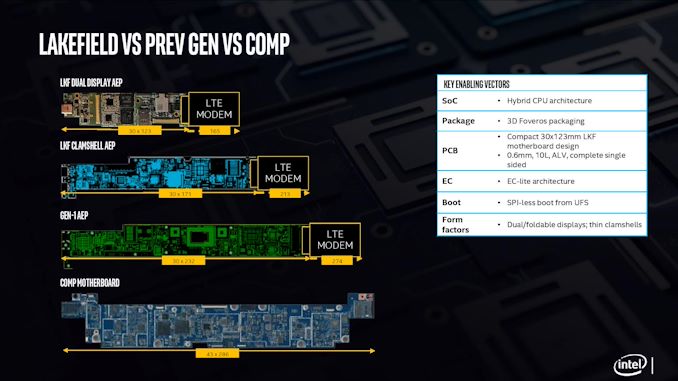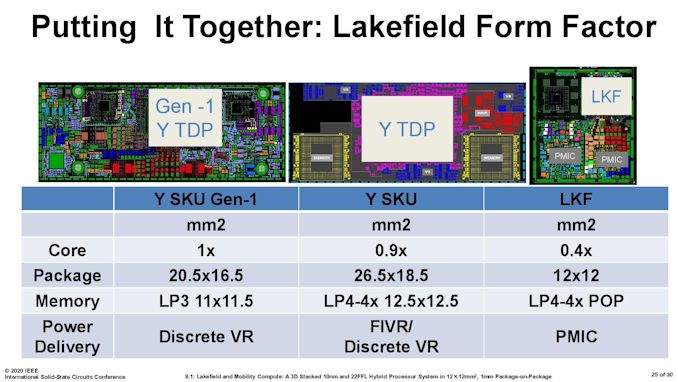The Intel Lakefield Deep Dive: Everything To Know About the First x86 Hybrid CPU
by Dr. Ian Cutress on July 2, 2020 9:00 AM ESTLakefield in Terms of Laptop Size
In a traditional AMD or Intel processor designed for laptops, we experience two to eight processing cores, along with some graphics performance, and it is up to the company to build the chip with the aim of hitting the right efficiency point (15 W, or 35/45 W) to enable the best performance for a given power window. These processors also contain a lot of extra connectivity and functionality, such as a dual channel memory controller, extra PCIe lanes to support external graphics, support for USB port connectivity or an external connectivity hub, or in the case of Intel’s latest designs, support for Thunderbolt built right into the silicon without the need for an external controller. These processors typically have physical dimensions of 150 square millimeters or more, and in a notebook, when paired with the additional power delivery and controllers needed such as Wi-Fi and modems, can tend towards the board inside the system (the motherboard) totaling 15 square inches total.

One of Qualcomm’s examples from 2018
For a Qualcomm processor designed for laptops, the silicon is a paired down to the essentials commonly associated with a smartphone. This means that modem connectivity is built into the processor, and the hardware associated with power delivery and USB are all on the scale of a smartphone. This means a motherboard designed around a Qualcomm processor will be around half the size, enabling different form factors, or more battery capacity in the same size laptop chassis.
With Intel’s new Lakefield processor design, the chip is a lot smaller than previous Intel implementations. The company designed the processor from the ground up, with as much included on the CPU as to not need additional chips on the motherboard, and to fit the dimensions similar to one of Qualcomm’s processors. Above is a slide showing how Intel believes that with an LTE modem included, a Lakefield motherboard can move down to 7.7 square inches, similar to a Qualcomm design. This leaves more room for battery inside a device.
When Intel compares it against its own previous low power CPU implementations, the company quotes a 60% decrease in overall board area compared to its first generation 4.5 W processors.
It is worth noting that for power delivery, Intel placed MIMCAPs inside the Lakefield silicon, much like a smartphone processor, and as a result it can get by on the power delivery implementation with a pair of PMICs (power management ICs). The reason why there is two is because of the two silicon dies inside – they are controlled differently for power for a number of technical reasons. If each layer within an active stacked implementation requires its own PMIC, that would presumably put an upper limit on future stacked designs – I fully expect Intel to be working on some sort of solution for this for it not to be an issue, however that wasn’t implemented in time for Lakefield.
For those that are interested, Lakefield’s PMICs are under the codenames Warren Cove and Castro Cover, and were developed in 2017-2018.












221 Comments
View All Comments
serendip - Thursday, July 2, 2020 - link
The ARM MacOS devices could be mobile powerhouses at (gasp!) equal price points as Windows devices running either ARM or x86. Imagine a $1000 Macbook A13 or A14 with double the performance than a Surface Pro X or Galaxy Book S costing the same.lmcd - Friday, July 3, 2020 - link
Considering the hurdles just to use any form of open source software with the platform, they're not equal.JayNor - Thursday, July 2, 2020 - link
Intel already makes LTE modems. By chiplet, I am referring to the Foveros 3D stackable chiplets in this case ... Intel also makes emib stitched chiplet form features for their FPGAs. So, not just a marketing term. These have to implement certain bus interfaces or TSV placement requirements to work with the FPGA or Foveros manufacturing.henryiv - Thursday, July 2, 2020 - link
What a shame to disable AVX-512. The circuitry is probably left there to support SSE, which is still a common denominator with Tremont cores. Also, 5 cores not running together is a huge huge bummer.This first generation is an experimental product and is to be avoided. In the next generation, the Tremont successor will probably get at least 256-bit AVX support, which will be finally possible to use across 5 cores. Transition to 7nm should also give the elbow room needed to run all 5 cores at the same time at full throttle within the limited 7w power budget.
jeremyshaw - Thursday, July 2, 2020 - link
By the usual Intel Atom timeline, it will be 2023 before a Tremont successor comes out. By then, will anyone even care about Intel releases anymore?lmcd - Thursday, July 2, 2020 - link
Bad joke, right? Intel is signaling that Atom is moving to the center of their business model. Previous times Intel prioritized Atom, Atom got every-other-year updates. I'd expect a 2022 core or sooner, if you assume Tremont was "ready" in 2019 but had no products (given 10nm delays and priority to Ice Lake).serendip - Friday, July 3, 2020 - link
Moving Atom to the center of their business model? Atom is still being treated as an also-ran.Intel now has to contend with a resurgent AMD gobbling up x86 market share in multiple segments and ARM encroaching on consumer and server segments. Putting Atom as a priority product would be suicidal.
Lucky Stripes 99 - Saturday, July 4, 2020 - link
Not really. The ARM big/little design has been fairly successful. Most likely is that you'll see the walls between Atom and Core break down a bit in order to keep code optimizations happy on either core type.Deicidium369 - Saturday, July 4, 2020 - link
revenues show they are gobbling up nothing.Namisecond - Saturday, July 11, 2020 - link
There is a limit to the amount of market share AMD can gobble up and they are currently at or near their limit. AMD is production limited and always will be.